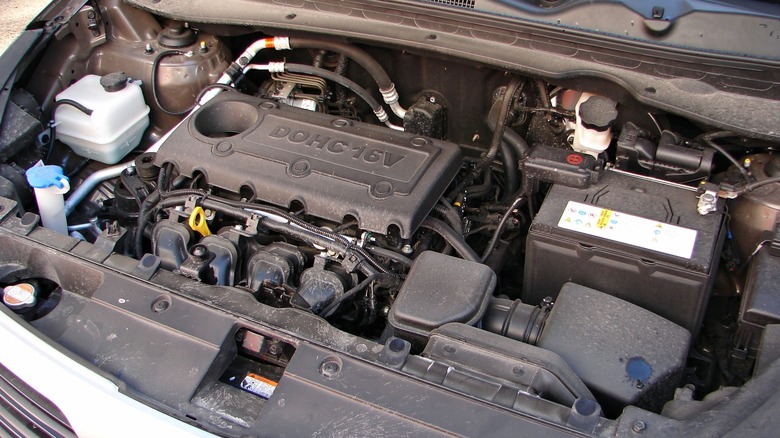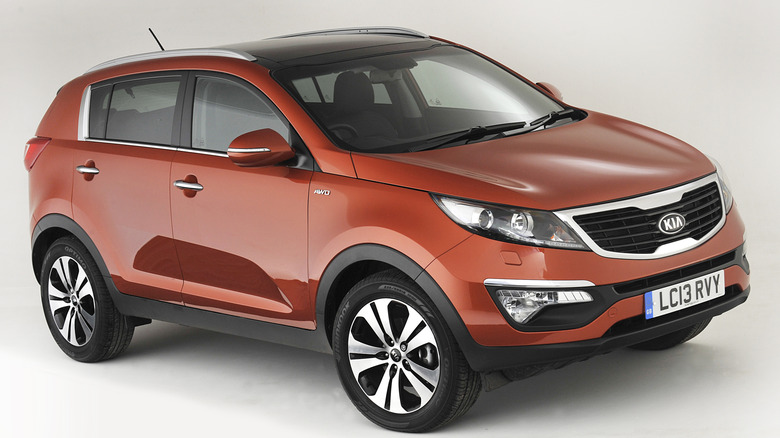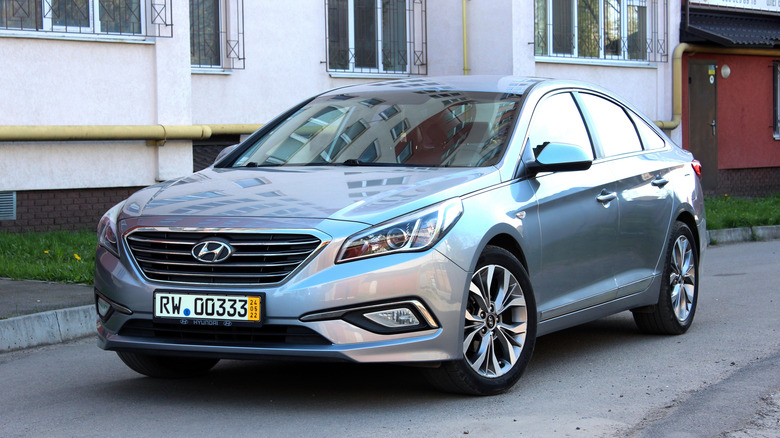Common Problems With Kia & Hyundai's Theta Engines
The launch of Hyundai's first Theta engine in the 2004 Sonata helped signify that the Korean automaker was moving beyond its 20th-century origins. Available in 2.0- and 2.4-liter displacements, the all-aluminum powerplant promised more power and reduced fuel consumption. The company's engine development would later include the Theta II, which was announced in 2009.
At its launch, then-Hyundai Motor America President and CEO John Krafcik stated that Theta II-powered cars, like the Sonata, were part of Hyundai's "promise to deliver unparalleled quality and value to our customers." That pledge wouldn't be completely fulfilled, as the Theta II would be at the heart of recalls and a record-setting class-action suit involving millions of cars in the U.S. due to engine failure.
The Theta II engine was Hyundai's go-to engine for much of the 2010s, finding a home in bread-and-butter models like the Santa Fe, Tucson, and Sonata. Hyundai's sister automaker, Kia, also made thorough use of the Theta II during the same period in the Forte, Forte Koup, Optima, Sorento, and Sportage. Owners and prospective buyers can visit the Hyundai and Kia websites to check whether a particular vehicle is involved in a recall or safety campaign. Recall information is also available through the National Highway Traffic Safety Administration (NHTSA). Let's dive into the engine failure issue and other problems associated with this Hyundai powerplant.
The Theta II engine had a habit of failing
The most severe problem with the Theta II powerplant is the potential for engine failure. This trouble came to light in a 2015 recall involving select 2011 and 2012 Hyundai models. NHTSA documentation revealed that metallic debris wasn't removed during the manufacturing process for Theta II units at Hyundai's Alabama factory. The residue accumulated inside the engine, near the crankshaft, and could potentially interfere with oil flow. In this situation, the connecting rod bearings don't receive sufficient lubrication, causing damage to the connecting rods and, ultimately, leading to engine seizure. Hyundai expanded the recall in 2017 to cover additional model years. Kia became part of the greater recall effort around the same time.
The NHTSA advises that a knocking noise is a typical indicator of a worn connecting rod bearing. Further warnings may appear as a check engine light or an oil pressure warning on the dashboard. Should the bearing fail, the vehicle is vulnerable to stalling, which could cause a safety hazard while driving. Hyundai and Kia developed a knock sensor detection system that can be installed in affected vehicles to prevent connecting rod failure.
Unsurprisingly, the Theta family didn't make our list of the most reliable Hyundai engines. Similarly, the engine came in for criticism when we looked at the most reliable Kia engines, where we called out early Theta engines for being problematic.
Other Hyundai and Kia Theta engine problems
Besides connecting rod and engine seizure problems, the Theta II powerplant has a reputation for carbon buildup on intake valves and excessive oil consumption. The engine uses a gasoline direct injection (GDI) system that bypasses intake valves and sprays gasoline directly into the combustion chamber. While this approach helps with fuel economy and emissions, the engine valves can develop carbon buildup because the fuel doesn't offer any cleaning effect. That makes periodic intake valve cleaning part and parcel of running a GDI engine.
Excessive oil consumption is another concern with Theta II engines. For instance, CarComplaints.com calls out the 2011-2013 and 2015 Hyundai Sonata for this issue, with some model years earning "avoid like the plague" or "clunker" status. An insufficient oil level can affect engine lubrication, leading to premature wear of internal components. A 2020 technical service bulletin (TSB) highlighted excessive oil consumption in various Kia models with the Theta and other engines from the 2011 through 2022 model years. The document reports that the issue can cause oil sludge, abnormal engine wear, and carbon buildup.


